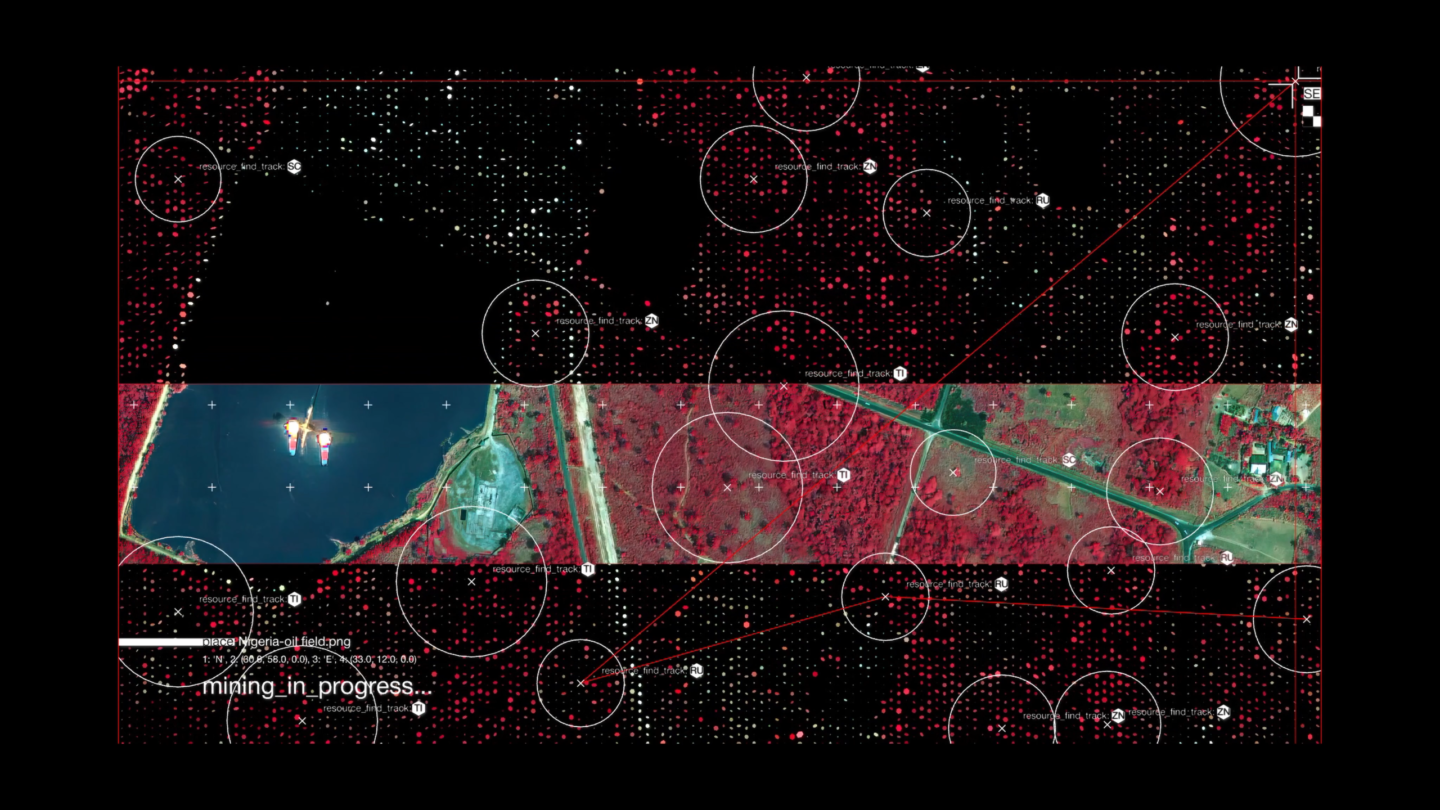KEYWORDS
AI, extraction, hyperspectral imaging, Google Earth, cubesat, space, anthropocene, post-anthropocene.
HYPERMINER_EXTRACTED EARTH explores the HYPER EXTRACTION of natural and economically valuable resources using advanced mining acceleration technologies by the means of hyperspectral imaging, artificial intelligence and data-driven decision making.
WHAT DO YOU SEE In the artwork we see how deposits are allocated, extracted (speculative) and used to create a new geode composed of the most valuable natural resources found on Earth.
TRIPTYCH
Screen one: a cubesat in orbit is scanning Earth for rare earth deposits. Screen two: valuable natural deposits are allocated via machine learning, hyperspectral imaging and detection. Valuable natural elements like rare earth metals are mined. Screen three: rare earth elements are used to create a geode (extracted earth).
PROJECT CONTEXTUALISATION
Hyperspectral data from CUBESATs equipped with machine vision in outer space are used to allocate deposits and natural resources on Earth with unprecedented accuracy and vision. As major discoveries of near-surface mineral deposits are declining globally, new methods are needed to detect economical deposits at great depths. However, this is challenging due to the relatively small size of ore deposits, the limited number of existing geological data at depth, and limitations of the geophysical methods used for their detection. Machine learning can aid in developing better models for the prediction of rock type and economical mineral deposit locations for extraction purposes without engaging in time and resource-intensive approaches.
GENERAL CONTEXTUALISATION
The need for monitoring environmental dynamics is now even more urgent given the acknowledged impact of climate change, sustainable food sources, and intensified need for green energy. Different visualisation tools exist for geospatial data, however, these are not suited to capture the complexity of hyperspectral imagery. This makes our project relevant, trans-sectoral and trans-disciplinary.
TECHNICAL INFO
The audiovisual artwork is made in Touchdesigner. The installation can run realtime or presented as a video (2K/4K/8K). Realtime data from Google Earth is combined with hyperspectral images from satellites with embedded machine learning.
USEFUL INFO
We are currently discussing with a hyperspectral cubsat company the possibility of collaborating and elaborating on our current setup to track waste in the oceans.
CREDITS
The project was realised during the “Geographies of an AI” residency organised by the Onassis Stegi Foundation, 2020/21. Warm thanks to Daphe Dragona and Michelle Kasprzak for their valuable input. We also thank SCANWORLD for helping us out with hyperspectral data and images. We also would like to thank GOOGLE EARTH.
PRODUCTION
Studio De Wilde © all rights reserved – 2021 INQUIRIES studio.frederik.de.wilde@gmail.com
Frederik De Wilde is a multi-awarded artist based in Antwerp, Belgium. He studied fine arts, media arts and philosophy. His artistic praxis situates itself on the interstice of art-science-technology and design exploring notions of the inaudible and intangible. His art is grounded in the interaction between complex systems rooted in dark ecologies and invisible territories. De Wilde critically examines the radical shifts technology imposes on society and our “environment,” which he explores sometimes on the side of the technological, often in the conceptual, perceptual, sensorial and human register. Ultimately he seeks to (re-)connect our humanness – which requires a symbolic rewiring – while making us excited for the future and the unknown.
An excellent example is the conceptualisation of the pioneering original Blackest-Black (a new nano-engineered colour for a new industrial revolution exploring the nature of nothingness) made in collaboration with Rice University and NASA. The project received the 2010 Ars Electronica Next Idea Award and the Best European Collaboration Award between an artist and a scientist.
Frederik collaborated with the Karlsruhe Institute of Technology, the University of Leuven (Prometheus, division of Skeletal Tissue Engineering), Hasselt University (I-BioStat), UGent (Textile Department), Wyoming University, and many other organisations (e.g. ESTEC, NASA) worldwide. He published several essays and papers, such as “Artistic Approaches to Design and Manufacturing Techniques Dedicated to Space Applications” for MIT press and “The Art of Ethics in the Information Society: Mind You” for Chicago University and Amsterdam University Press. He also has exhibited at notable places such as BOZAR Museum of Fine Arts (Belgium), ZKM (Germany), Carnegie Museum of Arts (USA), Venice Biennial 2017 (Italy), Art Basel (Switzerland), Tetem (Netherlands), Singapore Art Science Museum (Singapore), MAAT museum (Portugal), Centre Pompidou (France), National Gallery Singapore (Singapore) and many others.
Frederik currently holds a position as affiliated artist at the University of the West of England in the The Unconventional Computing Laboratory, founded by Prof Andy Adamatzky in 2001 as a response to an urgent need to develop computers for future centuries and explore complex dynamics of nonlinear systems.
